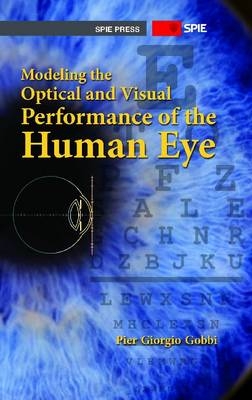
Modeling the Optical and Visual Performance of the Human Eye
Seiten
2013
SPIE Press (Verlag)
978-0-8194-9254-8 (ISBN)
SPIE Press (Verlag)
978-0-8194-9254-8 (ISBN)
- Titel z.Zt. nicht lieferbar
- Versandkostenfrei innerhalb Deutschlands
- Auch auf Rechnung
- Verfügbarkeit in der Filiale vor Ort prüfen
- Artikel merken
This book provides a faithful and robust simulation of the optical and visual performances of the human eye for axial vision of distant objects in a variety of visual conditions. The author moves from intrinsically theoretical aspects (the optical and neurophysical models of the eye) to include a great number of experimental measurements from the scientific literature, in order to adapt the model parameters to the observed phenomenology and validate the predictivity power of the models themselves. The results are very satisfactory in terms of quantitative and qualitative adherence of model predictions to field measurements.
Resulting from the author's investigations over the last decade, the book material is largely original, and the most relevant achievement can be found in the capacity to evaluate visual acuity for a range of visual conditions, such as variations in pupil size, refractive error, and ambient illumination.
Thanks to the general organisation of the book, chapters and paragraphs with high level mathematical and physical optics content can be safely skipped without compromising the overall comprehension. To this end, a brief summary is provided at the end of each chapter, making this book appropriate for readers with greatly varying degrees of technical knowledge.|This book provides a faithful and robust simulation of the optical and visual performances of the human eye for axial vision of distant objects in a variety of visual conditions. The author moves from intrinsically theoretical aspects (the optical and neurophysical models of the eye) to include a great number of experimental measurements from the scientific literature, in order to adapt the model parameters to the observed phenomenology and validate the predictivity power of the models themselves. The results are very satisfactory in terms of quantitative and qualitative adherence of model predictions to field measurements.
Resulting from the author's investigations over the last decade, the book material is largely original, and the most relevant achievement can be found in the capacity to evaluate visual acuity for a range of visual conditions, such as variations in pupil size, refractive error, and ambient illumination.
Thanks to the general organisation of the book, chapters and paragraphs with high level mathematical and physical optics content can be safely skipped without compromising the overall comprehension. To this end, a brief summary is provided at the end of each chapter, making this book appropriate for readers with greatly varying degrees of technical knowledge.
Resulting from the author's investigations over the last decade, the book material is largely original, and the most relevant achievement can be found in the capacity to evaluate visual acuity for a range of visual conditions, such as variations in pupil size, refractive error, and ambient illumination.
Thanks to the general organisation of the book, chapters and paragraphs with high level mathematical and physical optics content can be safely skipped without compromising the overall comprehension. To this end, a brief summary is provided at the end of each chapter, making this book appropriate for readers with greatly varying degrees of technical knowledge.|This book provides a faithful and robust simulation of the optical and visual performances of the human eye for axial vision of distant objects in a variety of visual conditions. The author moves from intrinsically theoretical aspects (the optical and neurophysical models of the eye) to include a great number of experimental measurements from the scientific literature, in order to adapt the model parameters to the observed phenomenology and validate the predictivity power of the models themselves. The results are very satisfactory in terms of quantitative and qualitative adherence of model predictions to field measurements.
Resulting from the author's investigations over the last decade, the book material is largely original, and the most relevant achievement can be found in the capacity to evaluate visual acuity for a range of visual conditions, such as variations in pupil size, refractive error, and ambient illumination.
Thanks to the general organisation of the book, chapters and paragraphs with high level mathematical and physical optics content can be safely skipped without compromising the overall comprehension. To this end, a brief summary is provided at the end of each chapter, making this book appropriate for readers with greatly varying degrees of technical knowledge.
G. Sreenivasan is Resident Engineer, Kerala State Electricity Board, New Delhi. He has been Guest Faculty in various premier institutes such as Engineering Staff College of India (ESCI), Hyderabad; Reliance Energy Management Institute (REMI), Mumbai; and Central Institute for Rural Electrification, Hyderabad. G. Sreenivasan has worked with the Anti-Power Theft Squad of the Kerala State Electricity Board in various capacities and has been instrumental in unearthing many cases of power thefts which continue to plague our economy.
| Reihe/Serie | Press Monographs |
|---|---|
| Verlagsort | Bellingham |
| Sprache | englisch |
| Gewicht | 754 g |
| Themenwelt | Studium ► 1. Studienabschnitt (Vorklinik) ► Anatomie / Neuroanatomie |
| Technik ► Medizintechnik | |
| ISBN-10 | 0-8194-9254-X / 081949254X |
| ISBN-13 | 978-0-8194-9254-8 / 9780819492548 |
| Zustand | Neuware |
| Haben Sie eine Frage zum Produkt? |
Mehr entdecken
aus dem Bereich
aus dem Bereich
Buch | Hardcover (2022)
Urban & Fischer in Elsevier (Verlag)
220,00 €
Struktur und Funktion
Buch | Softcover (2021)
Urban & Fischer in Elsevier (Verlag)
44,00 €
+ Web + Lehrbuch
Buch | Hardcover (2022)
Urban & Fischer in Elsevier (Verlag)
249,00 €


